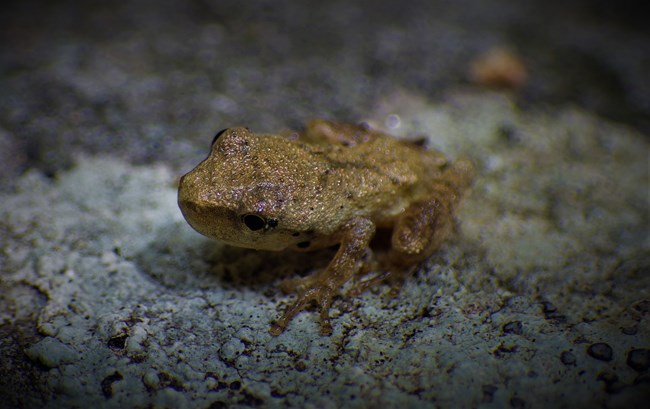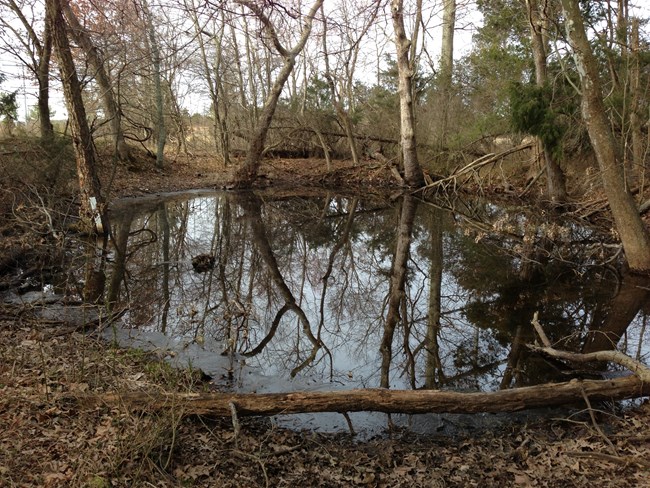Last updated: April 12, 2022
Article
Amphibian Diversity & Habitat Connectivity

NPS/Lindsey Pekurny
Importance
Habitat fragmentation is a major threat to amphibian communities. It can alter species distributions and lead to a loss of species diversity. Because amphibians are very sensitive to environmental change, amphibians in National Capital Region (NCR) parks are especially at risk from fragmentation due to the region’s growing urbanization.
Scientists from Michigan State University and the U.S. Geological Survey who collaborate with the National Capital Region Inventory & Monitoring Network, recently published a study looking at how fragmentation and other factors affect
amphibian communities at NCR parks. The study looked at which landscape-scale factors affect the number of species at a park, and which local-scale factors affect the number of species at a particular wetland.
Factors Influencing Species Richness at a Park
- Park area
- % Forest cover
- Degree of isolation (how much of the area surrounding the park is not potential amphibian habitat)
Factors Influencing Species Richness at Individual Wetlands
- Wetland area
- Wetland connectivity (combination of all known wetlands and amphibian dispersal distances)
- Water conductivity (the amount of salts and other materials—usually pollutants—dissolved in water, measured by the water’s capacity to conduct electricity)
- Wetland hydroperiod (the amount of time a wetland stays wet)
- Precipitation

NPS
Results
At the landscape scale, parks that are smaller and more isolated have fewer amphibian species.
At the local scale, wetlands that are closer together and larger have more species, since these characteristics help in the movement and successful breeding of adults amphibians. Wetlands containing water with high conductivity, indicating lots of dissolved material and poor water quality, had fewer species. The ability of a wetland to retain water (hydroperiod) throughout the breeding season had the biggest effect of all factors at the wetland-level, since a longer wet period is critical for successful metamorphosis of tadpoles to adults.
Managing for Amphibians
If parks aim to maintain amphibian species richness, potential management actions
include:
- actively managing for larger wetlands and wetlands that stay wet longer
- preventing roads, trails, or other interruptions that break up and fragment individual wetlands and groups of wetlands
- limiting roads near wetlands to minimize run-off contamination
References:
Wright AD, Grant EHC, and Zipkin EF. 2020. A hierarchical analysis of habitat area, connectivity, and quality on amphibian diversity across spatial scales. Landscape Ecology.
National Park Service (2005) Long-term monitoring plan for natural resources in the National Capitol Region Network. Inventory and Monitoring Program, Center for Urban Ecology. Washington D.C.
Learn More about the National Park Service's Inventory & Monitoring Efforts
To help protect natural resources ranging from bird populations to forest health to water quality, National Park Service scientists perform ecological Inventory & Monitoring (I&M) work in parks across the country. The National Capital Region Network, Inventory & Monitoring program (NCRN I&M) serves national parks in the greater Washington, DC area. To learn more about NCRN I&M amphibian monitoring, you can visit the NCRN amphibian monitoring webpage.
A printable version of this resource brief is also available.
Tags
- antietam national battlefield
- baltimore-washington parkway
- catoctin mountain park
- chesapeake & ohio canal national historical park
- george washington memorial parkway
- greenbelt park
- harpers ferry national historical park
- kenilworth park & aquatic gardens
- manassas national battlefield park
- monocacy national battlefield
- national capital parks-east
- piscataway park
- prince william forest park
- rock creek park
- wolf trap national park for the performing arts
- ncrn
- amphibians
- fragmentation
- connectivity
- wetlands
- biodiversity
